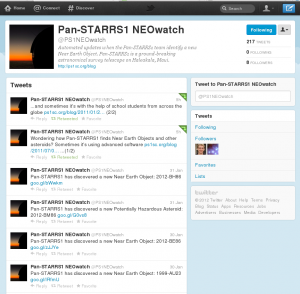PS1SC Blog
Pan-STARRS is a groundbreaking project to survey the sky visible from Hawai`i looking for undiscovered asteroids, distant exploding stars and much more.
If you have questions about the blog please contact blog AT ps1sc.org.
Powered by 
February 3rd, 2012 by ps1scblog

The new @PS1NEOwatch feed tweets when PS1 finds a new Near Earth Object
From today onwards you can see tweets of new Near Earth Objects identified by Pan-STARRS1. Follow @PS1NEOwatch for updates of new PS1 NEOs. If you want to know more about how PS1 finds asteroids then why not check out the following blog posts.
MOPS: Finding things that go bump in the night where Larry describes how advanced software helps Pan-STARRS identify rocks that could come very close to the Earth.
School students find hundreds of potential new asteroids with PS1 where Will Burgett outlines work being done by school students across the globe to identify new asteroids.
Posted in Inner Solar System
Please feel free to comment on this article, selected comments will be published. Comments are moderated and their content are the opinions of the comment authors and not PS1SC, its member institutions or funding bodies.
Leave a Reply
The Pan-STARRS Project is being led by the University of Hawaii Institute for Astronomy, and exploits the unique combination of superb observing sites and technical and scientific expertise available in Hawaii. Funding for the development of the observing system has been provided by the United States Air Force Research Laboratory. The PS1 Surveys have been made possible through contributions by the Institute for Astronomy, the University of Hawaii, the Pan-STARRS Project Office, the Max-Planck Society and its participating institutes, the Max Planck Institute for Astronomy, Heidelberg and the Max Planck Institute for Extraterrestrial Physics, Garching, The Johns Hopkins University, Durham University, the University of Edinburgh, the Queen's University Belfast, the Harvard-Smithsonian Center for Astrophysics, the Las Cumbres Observatory Global Telescope Network, Incorporated, the National Central University of Taiwan, and the National Aeronautics and Space Administration under Grant No. NNX08AR22G issued through the Planetary Science Division of the NASA Science Mission Directorate. Any opinions, findings, and conclusions or recommendations expressed in this article are those of the author(s), and do not necessarily reflect the views of the National Aeronautics and Space Administration, the PS1 Science Consortium or its member institutions.











[...] cool tools that can be used to visualize our solar system in 3D without leaving your chair. PS1SC blog announced that tweets will be made of near earth objects that have been newly identified by [...]